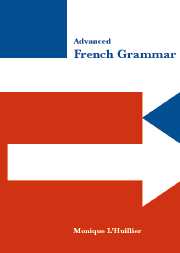3 - Pronunciation, spelling, registers, punctuation
Published online by Cambridge University Press: 05 June 2012
Summary
Introduction
A phoneme is an abstract unit of sound (‘the smallest distinctive unit of the language’) which can be heard with a variety of pronunciations but which can be understood despite these variations. There are 36 phonemes in French (46 in standard English), represented by the signs of the International Phonetic Alphabet (IPA). A good dictionary will give the pronunciation of words using this alphabet, which is to be found in square brackets after the word concerned (e.g. phonème [fᴐnεm]).
There are three types of sound in French: vowels (voyelles), consonants (consonnes) and glides, also called semi-consonants (semi-consonnes) or semi-vowels (semi-voyelles).
Phonetic transcriptions are conventionally written in square brackets. In the tables below, the sounds to be learnt are on the left, followed by illustrative examples and their full transcriptions in the IPA.
Vowels
There are 16 vowels, divided into two categories: oral and nasal.
Oral vowels
[i] petit [p∂ti]; maïs [mais]
[y] voulu [vuly]; (il a) eu [y]
[u] vous [vu]; goût [gu]
[e] été [ete]; chez [∫e]; les [|e]
[ε] lait [|ε], belle [bε|]; mais [mε]
[ø] peu [pø]; gazeux [gazø]; neutre [nøtr]; bœufs [bø]; jeûne [3øn]
[œ] beurre [bœr], peur [pœr]; bœuf [bœf]; jeune [3œn]
[∂] demi [d∂mi]; je [3∂]
[o] eau [o]; rose [roz]; mot [mo]; saule [so|]; (le) nôtre [notr]
[ᴐ] pomme [pᴐm]; bord [bᴐr]; vogue [vᴐg]; sol [Sᴐ|]; notre [nᴐtr]
[a] la [|a]; là [|a]; patte [pat]; chat [∫a]; voie [vwa]
[α] âtre [αtr], pâte [pαt], phrase [frαz], bas [bα]
- Type
- Chapter
- Information
- Advanced French Grammar , pp. 46 - 62Publisher: Cambridge University PressPrint publication year: 1999



